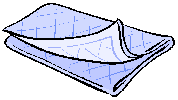As we move into Part 3 – Quilt Storage – with light, humidity, temperature and clean conditions in mind, let’s think about how to put quilts away when they are not being used.
Part 3 – QUILT STORAGE
Where?
One of the best places to store a quilt is in a low-lit, relatively-unused bedroom – on the bed! It will not have fold lines, it will have plenty of air, and it won’t be bothered by excess light or humidity. Layering quilts on that same bed is an option that we sometimes forget. Rotate the quilts every few months so that the one on the bottom doesn’t suffer!
Sometimes, that’s just not possible. There’s no “extra bedroom,” or – the best possible problem – you have too many quilts and simply need to put some away.
To Roll or Not to Roll?
 Many museums have maintained a rolling process using wooden dowels or cardboard cores. The quilt is completely covered with a cotton or muslin covering so that the quilt does not touch the dowel itself. The dowels can be hung on large hooks, and many can be stored on one wall. While this method seems logical and is still used, experts have recently suggested that the process of rolling actually stretches the quilt and breaks down fibers.
Many museums have maintained a rolling process using wooden dowels or cardboard cores. The quilt is completely covered with a cotton or muslin covering so that the quilt does not touch the dowel itself. The dowels can be hung on large hooks, and many can be stored on one wall. While this method seems logical and is still used, experts have recently suggested that the process of rolling actually stretches the quilt and breaks down fibers.
Ouch!
Why all the fuss about folding and storage? Many quilts, especially antique ones, have traditionally been folded in half, then half again. Folding in a different way takes the fold strain away from the original fold lines. Never re-fold a quilt the same way twice!
Bias Folding
Here’s a different method for you to try: bias folding. Folding the quilt on the bias, using muslin, sheets, or acid-free tissue inside or in between the layers (especially tissue crumpled in the fold), then placing the loosely folded quilt into a large washed cotton pillowcase or sheet is a better alternative when a quilt must be stored. Create this bias fold by simply folding each corner to the center, and then continuing in this manner until the quilt fits the storage space or container. Just like bias binding, the fabric fibers will last longer and be less stressed than if folded along the fiber line.
Inside Out? Outside In?
 Many quilters believe that the best way to fold a quilt is so that the front of the quilt is to the outside. Logically, there is more stress on a quilt’s inner folds because they are tighter, and more wear will occur. Of course, logic doesn’t always prevail when protectiveness takes over.
Many quilters believe that the best way to fold a quilt is so that the front of the quilt is to the outside. Logically, there is more stress on a quilt’s inner folds because they are tighter, and more wear will occur. Of course, logic doesn’t always prevail when protectiveness takes over.
Acid-free is Best
Paper contains acids that can break down fibers. It’s wise to become familiar with acid-free tissue paper and acid-free boxes for storing your precious quilts. No matter how or where you choose to store your quilts, it helps to crumple some acid-free tissue paper into the folds. The folds will not be tight, and your fabric will remain safe from harm.
Don’t Touch!
If you use cardboard boxes, wooden chests, or drawers, be certain that the quilt is not touching the surface. Protect it with a cotton sheet or several layers of white (preferably acid-free tissue). Natural substances in woods can react with quilting fabrics, making staining likely. Remember that the stored quilts should be out of humid areas and away from temperature fluctuations. Plastic storage containers should only be used in the most arid climates, because sealing humidity into the container with the quilt can lead to mildew and fiber damage.
Hang It!
Hanging is another very acceptable option for quilts – when a proper quilt sleeve (a fabric tube approximately 4”wide sewn across the top) is used, the quilt will not be damaged, especially when rotated with another quilt every 6 months (remembering the sunlight factor – try not to hang it in strong light). If you choose to hang your quilt over a wooden quilt rack or other rod, be sure that there is a protective layer between the quilt and the wood.
Don’t just store and forget them – catch potential danger to quilts before it causes damage. Better yet – take care of your quilts from the start, use them often, and when you have to put them away, think twice about your storage conditions.